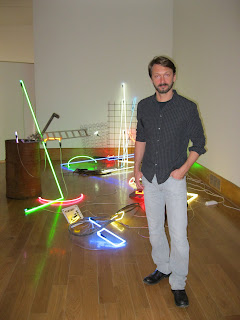Two local exhibitions show off the talents of innovative young international artists staking out territory in Post Modern history. Anselm Reyle and Jesse Small both work dialectically, creating a new kind of art by pushing old icons and clichés into seemingly disparate contexts.
 Forty year old German Anselm Reyle, whose exhibition plays the Des Moines Art Center (DMAC) through April 17, is a new kind of German artist who is proud to be part of the rising art scene of Berlin.
Forty year old German Anselm Reyle, whose exhibition plays the Des Moines Art Center (DMAC) through April 17, is a new kind of German artist who is proud to be part of the rising art scene of Berlin.
“Cologne is the past. Berlin is the future now,” he explains.
Reyle mentions Americans such as Jeff Koons, Barnett Newman and Gene Davis as influences while distancing himself from superstar German artists like Anselm Kieffer. Although one “Untitled” Reyle piece resembles a Kieffer masterpiece in the DMAC permanent collection, Reyle disavows any connection and points out differences - mainly those of mood. He is a rather gleeful German artist and no one ever accused Kieffer or his generation of much projecting much glee. Reyle admits to other contrary attitudes.
 “In my painting education, painting for effect was completely discouraged but I always liked such tricks. As a child my mother prohibited me from using paint by numbers formats. Now I use them for effect. As a child I was only allowed to play with hand made wooden toys. Now I play with all kinds of flashy toys and neon games,” he said.
“In my painting education, painting for effect was completely discouraged but I always liked such tricks. As a child my mother prohibited me from using paint by numbers formats. Now I use them for effect. As a child I was only allowed to play with hand made wooden toys. Now I play with all kinds of flashy toys and neon games,” he said.
Reyle frequents flea markets in search of materials and thinks the next big new thing might be an old thing with a new paint job. DMAC Director Jeff Fleming calls him “a taxidermist breathing new life into exhausted or dormant visual motifs.” Reyle’s art in DMAC’s exhibition includes chrome, bronze, piano lacquer, plinth, aluminum, glass, neon, electric cables, rust, plastic, LED lights, and wood veneer - as well as more traditional Modernist media.
“I am particularly interested in typical things - clichés from another era of Modernism like African sculpture and cave paintings. I see clichés not as negative things but as connections,” he said.
Reyle says his mother has come around, somewhat.
“She accepts my work and is glad it is successful. But she only accepts it as irony,” he laughed.
Small’s exhibition reveals a distinct new phase of an evolving artist. The 36 year old now splits his time now between studios in Los Angeles and southern China. His earlier work resembled Reyle’s in the way it tried to squeeze playful new interpretations out of old humorless icons. Small built a reputation for embellishing weaponry with high gloss glazes that made objects of brutality into ornaments of frivolity.
 Even today he says he can take his porcelain bombs through customs because the ornamentation disguises their identity.
Even today he says he can take his porcelain bombs through customs because the ornamentation disguises their identity.
Small no longer goes to flea markets though. He makes everything from scratch now, even plastic robots that might embellish his chandeliers. And everything he makes is now fully functional.
“Getting away from American culture, I realized that objects that are readily recognized in America, such as Jeeps and army helmets, have obscure meaning elsewhere. In China, people thought my army helmets were bicycle helmets and just thought it weird that anyone would make a bicycle helmet out of porcelain. So while working in China I got interested in more internationally recognized symbols and found that video games were pan cultural and pan generational,” he explained.
“Now I think I am going more for the throat of ornamentation. I am now actually making the items themselves - actual folding screens and chandeliers. They might be stylistically quite different but they are still functioning in their traditional fashion,” Small said.
That sets up a dialogue between the art and the gallery viewer.
“Is it a chandelier or a sculpture about a chandelier? And if it’s a chandelier, what is it doing in an art gallery?”
Go ask for yourself. Small exhibition continues at Moberg Gallery till March 18.




No comments:
Post a Comment